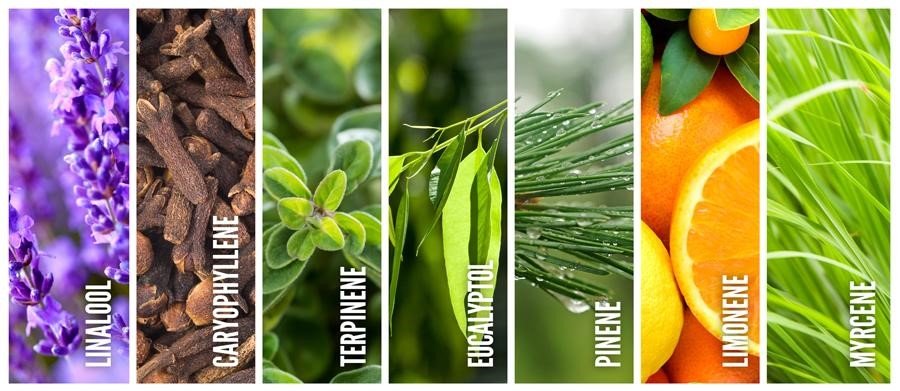What are terpenes?
Jun 15th 2021
Terpenes or terpenoids are aroma compounds produced in the flower and leaves of the cannabis plant. Research shows us that we can no longer just consider the potency of THC and CBD in a strain. The concentration of terpenes can provide as many benefits as potency and cannabinoid content.
Terpenes are responsible for the scent and flavor of cannabis. Tangerine Dream and Super Lemon Haze have distinctive citrus aromas, while Blackberry Kush and Strawberry Cough have sweeter, fruitier notes. Take a whiff of Sour Diesel and you’ll see why people love strong, skunky buds. To date, researchers have identified over 100 different terpenes, but below is a list of the most common ones.
Why do cannabis plants smell?
Terpenes are the primary elements of the essential oils in plants. They are responsible for the cannabis plant’s unmistakable flavor and aroma. Unlike other botanical species, each strain of cannabis has a unique terpene profile. Interestingly, many botanists and scientists believe that terpenes originally developed in plants as a deterrent to pests and animals. Some aroma compounds, like linalool, are even used in insect repellents. Though they were intended to be a protective mechanism, terpenes are ironically one of the most attractive aspects of the plant. Today, many medical cannabis patients rely on how their body gravitates to certain terpene profiles to help identify what strains may work for them.
What exactly are Terpenes?
Terpenes are organic hydrocarbons that occur naturally in the essential oils of plants. Technically, terpenes are a combination of carbon and hydrogen. Though the names are used interchangeably, terpenoids are actually terpenes that have been altered through a drying process.
Terpenes are produced in the trichomes. Trichomes are the mushroom-shaped, crystal-like resin glands that cover the flowers and leaves of the cannabis plant. Terpenes are volatile and evaporate easily which is why the cannabis plant is so easy to smell. Many terpenes, like camphor and menthol, found in the botanical world have medicinal benefits. If you’ve ever had a cough drop, you’ve experienced the soothing properties of menthol. Though there are thousands of terpenes in existence, there are at least 100 aroma compounds that have been identified in the cannabis plant.
What are the main functions of Terpenes?
Cannabis terpenes are responsible for the physiological effects associated with the plant. For instance, beta-caryophyllene is the only known terpene that can bind to cannabinoid receptors, specifically CB2 receptors. This is what makes beta-caryophyllene such a viable treatment for gastrointestinal conditions and auto-immune disorders. The activation of CB2 receptors can also reduce pain and inflammation.
Considered to have a range of medicinal properties, these aroma compounds work with cannabinoids to provide therapeutic relief to patients. Together, they create an “entourage effect” which enhances the singular therapeutic properties of the plant. The entourage effect is key to medicating effectively with cannabis. Patients should embrace the phenomenon of cannabinoids and terpenes interacting synergistically – always pick products that exhibit robust and natural terpene profiles. Every cannabis strain has varying percentages of terpene content. Though each terpene has specific medicinal properties, a diverse terpene profile can create a unique and powerful sense of relief.
Most common types of Terpenes
Terpenes are integral to how humans experience cannabis. From anti-inflammatory to sedative properties, scientists have only begun to scratch the surface of the medicinal benefits of these aroma compounds. To date, researchers have identified over 100 different cannabis terpenes, but only a handful of them are found in high concentration in cannabis. Below is a list of the most common types of terpenes.
β–Myrcene may be used to treat insomnia and pain. It is unique because it allows chemicals to cross the blood-brain barrier more easily, allowing for cannabinoids to have a faster onset. Myrcene may also increase the psychoactive effect of THC, making for a more intense cerebral high. Myrcene is naturally occurring in lemongrass, thyme, and hops.
Limonene has an energizing, citrus scent. It can be used for combatting gastric reflux and heartburn. Limonene has antifungal, antimicrobial and anti-inflammatory properties. It can be powerful for elevating mood and reducing stress. Limonene is often found in common cleaning and cosmetic products.
Humulene is found in abundance in its namesake Humulus lupulus, also known as common hops. It is present in ginseng, sage, clove, and basil. Used in ancient Chinese medicine, humulene can be an effective appetite suppressant. It has antibacterial, anti-inflammatory and antitumor properties.
Ocimene can have an herbaceous scent, often with citrus or woody undertones. Ocimene has shown significant anti-inflammatory effects. Many believe that this terpene was developed as part of a plant’s defense mechanism. Interestingly, pests seem to be averse to strains high in ocimene similar to how mosquitos avoid geranium. While many other plants have some quantity present, ocimene can be found in hops, basil, bergamot, orchids, and pepper.
Terpinolene is present in many cannabis strains, but usually only in small quantities. This terpene has a multi-dimensional aroma that smells like pine trees, citrus, herbs, and florals. It has illustrated antioxidant and sedative properties. Terpinolene is naturally occurring in nutmeg, tea tree, apples, and conifers.
Linalool has a delicate, floral aroma and is found in hundreds of different plants. Linalool is present in lavender, cinnamon, birch, and coriander. It is an age-old remedy for sleep disorders and can be used in treating depression and anxiety. Linalool can be used as an analgesic and is a great all-natural insecticide.
Pinene has a fresh, pine tree fragrance. It has anti-inflammatory effects. Studies have shown that it could be used as a bronchodilator and may be beneficial to those with asthma. Walk into a pine forest, take a deep breath and see how you feel. It also has antibiotic and gastroprotectant abilities. Pinene is most common in pine needles, rosemary, basil, and sage.
β–Caryophyllene is the only terpene known to directly interact with CB2 receptors. It has illustrated antibacterial and antioxidant properties, as well as promising results in pain management studies. β–Caryophyllene is naturally occurring in black pepper, rosemary, oregano, and cloves.

In Summary
Terpenes are an integral aspect of cannabis as a plant and medicine. From anti-inflammatory to chronic pain relief, the world of cannabis terpenes offers an impressive variety of therapeutic properties. These compounds define the flavor and aroma of our favorite plant, but can also alter the high from cannabis. Learn how to use terpenes to your benefit by experimenting with different strains and terpene profiles.

